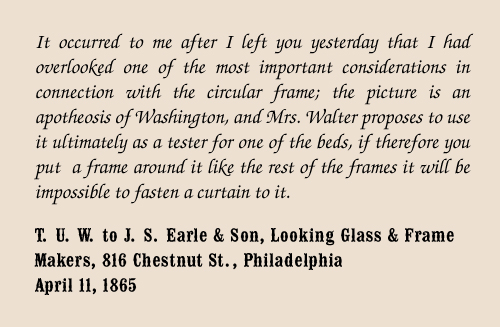
![]()

| If the statue of Freedom was the crowning achievement of the Capitol’s exterior, The Apotheosis of Washington was the crowning achievement for its interior. Inspired by the Panthéon in Paris, Walter designed a concave canopy to be suspended over the interior dome with sufficient space between to allow natural light (reflected by large mirrors and 1,083 gas lights) to illuminate a 4,664 square-foot fresco painting. Work on the painting was begun in 1863 by Italian-born artist Constantino Brumidi (1805-1880). With experience restoring Renaissance works at the Vatican in Rome, Brumidi came to the Capitol project in 1855 where he executed the very first frescoes in America for a House Committee meeting room. The Apotheosis was completed in January 1866. Walter, now retired himself, called it a “decided success,” and at a cost of $40,000, a bargain as well. At the Panthéon, the artist, Antoine Jean Gros had been paid 100,000 francs and was made a baron for his dome painting, but Brumidi’s fresco was one-third larger, 10 feet higher, and still a “far better painting.” |
 |
 |
| Study for The
Apotheosis of Washington Constantino Brumidi (1805-1880) Artist Oil on Canvas c. 1863 Brumidi prepared this study for Walter, who liked it enough that he took it to his Germantown residence, where the artist had done decorative painting during the work stoppage at the Capitol. Walter Collection, The Athenaeum of Philadelphia |
 |
| The Apotheosis of
Washington Contemporary print on Canvas from Digital Photograph 2012 Brumidi immortalized Thomas Ustick Walter by placing his likeness in the “Science” grouping, below and to the left of Washington. Placed between Benjamin Franklin and Robert Fulton, the figure is supposed to represent Samuel B. Morse, inventor of the telegraph, but is clearly the architect. Courtesy of The Architect of The Capitol |
 |
 |
|
 |
|
Copyright © 2012 The Athenaeum of Philadelphia